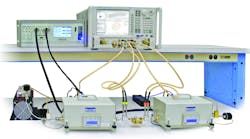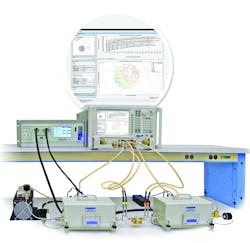Microwave components are generally designed to operate best in a 50-Ω environment. But the active devices (such as power transistors) that provide the high gain and output levels of active components (such as amplifiers) are typically far from 50 Ω in terms of their characteristic impedance. Measurements in the 50-Ω world of microwave signal generators and analyzers become quite tricky when trying to find the optimum impedance to match a power transistor to the outside, 50-Ω world.
That’s where a load-pull impedance tuner can truly pull its own weight. These are useful tools, whether used to find an impedance match for a non-50-Ω device under test (DUT) or to evaluate the effects of difference impedances on a 50-Ω DUT—e.g., checking device stability under severe impedance mismatches.
An impedance tuner is simple in concept…and anything but to implement. The basic idea is to provide some kind of variable impedance, or VSWR, across a bandwidth equal to that of the analyzer used with it. Variable impedance is usually achieved by means of a mechanical structure, like a slide-screw tuner. The tuner is turned by hand to vary the impedance it presents. The machining required to achieve consistent, repeatable changes in impedance with such a tuner must be extraordinary, especially at higher microwave and millimeter-wave frequencies.
This (and the specialized market) would explain why just a handful of suppliers provide microwave impedance tuners. Such mechanical impedance tuners can be made automatic through the addition of motors with enough precision to control the tuners in small steps. The motors can in turn be automated under microprocessor control and through the programming of specially written software.
Impedance tuners can be used at the input of a DUT, such as a low-noise transistor or amplifier, to measure the effects of different impedances on noise and gain; such tuners are known as source-pull tuners. Impedance tuners can also be designed for use at the output of a DUT, such as a power transistor or amplifier, to evaluate the effects of changing load impedance on various performance parameters (including output power, linearity, and efficiency). Such tuners are known as load-pull tuners.
As much as it is an art to design and fabricate impedance tuners that provide predictable, repeatable impedance across wide frequency ranges, it may require just as much skill to gain the full benefits of a source-pull or load-pull tuner system. They are often searching for something of a “mystical” optimum impedance. In a power amplifier, for example, they may be looking for the impedance that yields the best combination of output power, linearity, and power-added efficiency (PAE).
The parameters are often conflicting and achieve high-water markets at different load impedances. But somewhere, for a particular active device and amplifier circuit, lies a load impedance at which that circuit and device will yield the best combination of the parameters of interest. A similar case is true for a source-pull tuner and attempts to optimize parameters such as gain, noise figure, and compression point.
Specifying a source-pull or a load-pull tuner system depends upon identifying key requirements—among them, frequency range, power-handling capability, maximum impedance or VSWR range, repeatability, and the type of connector (which will depend upon frequency). In addition, different types of tuners and tuner systems are available for making load-pull measurements at second- and even third-harmonic frequencies in addition to the fundamental frequency. Such harmonic impedance tuners must of necessity cover extremely wide bandwidths using multiple, independently controllable tuners to performance simultaneous impedance tuning at different frequencies.
Because the number of suppliers of source-pull and load-pull tuners can, literally, be counted on one hand, the process of selecting a tuner or tuner system is simplified somewhat and will generally be determined—at least in frequency range—by the performance limits of the VNA that will be connected to the tuner. Making source-pull or load-pull measurements, whether on a wafer with a wafer probe or on a circuit in a test fixture, is certainly no trivial matter. Commercial impedance-tuner suppliers offer excellent software tools to help make those measurements somewhat less nerve-wracking.
In tandem with measurement software from leading VNA suppliers, the use of automatic source-pull and load-pull systems can find impedance points of interest. In addition they can provide graphical displays of linear S-parameters and nonlinear X-parameters in a fraction of the time taken by turning a screw tuner.


